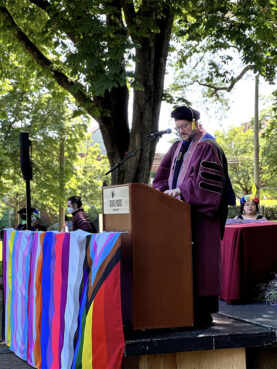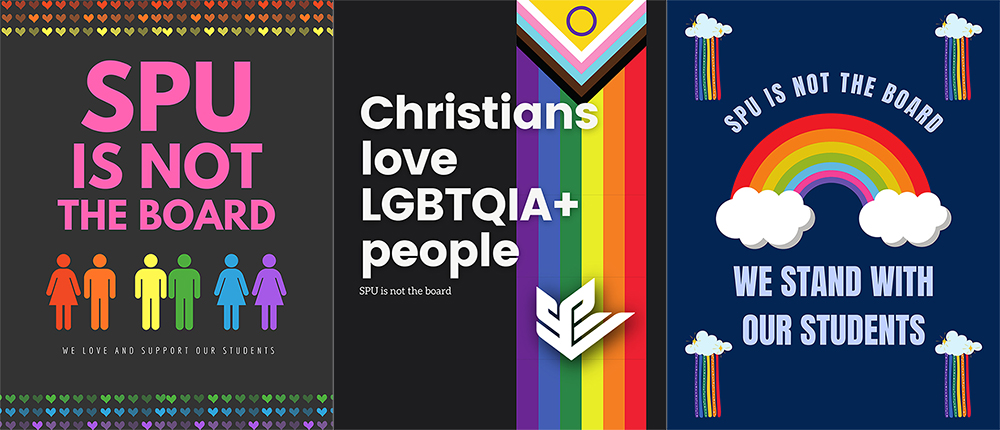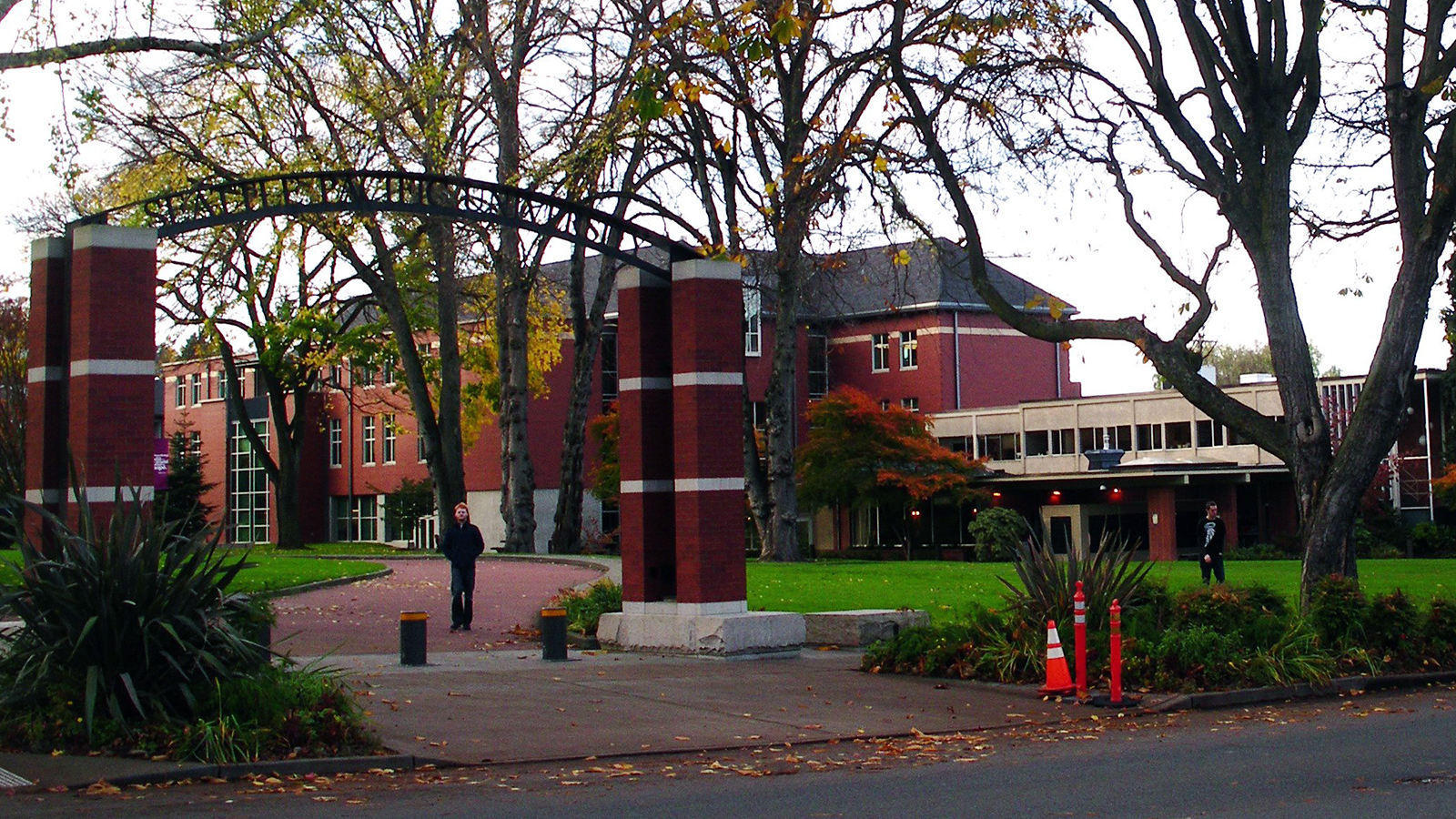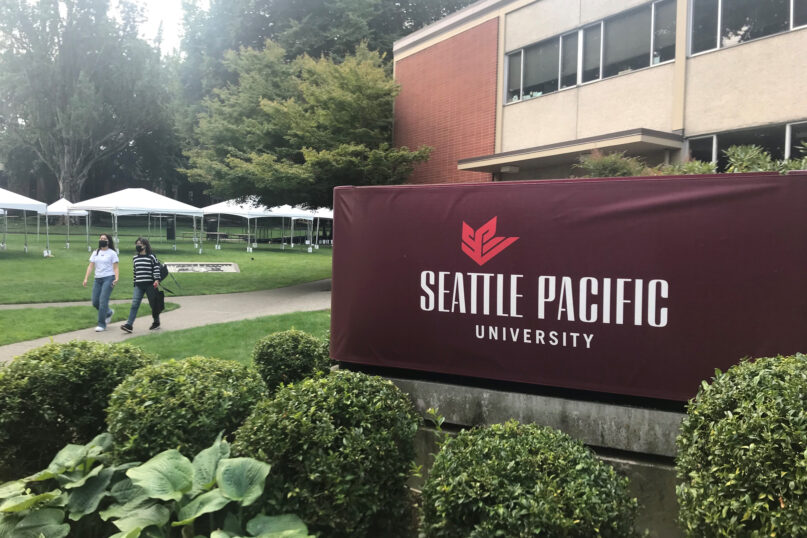(RNS) — Half a mile from the entrance to Seattle Pacific University, a massive billboard with a rainbow LGBTQ pride flag and the words “all are welcome” looms over a bustling intersection.
The billboard — placed by Pacific Lutheran University, a queer, inclusive Christian school about an hour south in Tacoma, Washington — is viewed by some as an intentional jab at SPU and its LGBTQ policies. In the past three years, the university, which is associated with the Free Methodist Church, has seen lawsuits, student sit-ins and rainbow-flag graduation protests against the university board’s ban on employee same-sex sexual activity.
Now, a new display policy for faculty and staff at the college says the university may “restrict expression” that is “incompatible with the mission and functioning of the University,” including displays that are attached to windows and building exteriors. It also gives the university the right to remove displays in violation of the policy without prior notice.
The new policy, according to students and faculty who oppose it, is targeting the pro-LGBTQ paraphernalia that has adorned numerous faculty windows and other areas of campus over the last three years.

Christopher Hanson speaks during a Lavender Graduation ceremony at Seattle Pacific University. Photo courtesy of Hanson
“This, to me, was yet another nail in the coffin to completely erase queer identity on campus,” Christopher Hanson, director of music education and the only openly queer faculty member at SPU, told Religion News Service.
Hanson, whose office door is “littered” with LGBTQ “propaganda,” described himself as the “right kind of queer, quote unquote” to pass the board’s policies, because he is bisexual and married to a woman.
Bill Purcell, professor of communication at SPU, sees the new policy as part of a larger pattern of conservative churches drawing a line in the sand on theological and social issues. He said administrators likely adopted the policy to realign the university with what they perceive as the values of the Free Methodist Church.
“I don’t think that they are necessarily intending to do it punitively,” Purcell said, “But it comes off that way.”
The policy was announced in July in an email sent to staff and faculty by Kim Sawers, vice president for business and finance. The email said no materials would be removed while faculty were away from campus for the summer. As of Thursday, Sept. 28, none of the faculty, staff or students reached by RNS had heard of displays being taken down.
“No one is going around randomly removing things,” Sawers told RNS. “Policies are meant to guide, and have consistent understanding and shared understanding. There are not display police coming around. That’s not what this is at all.”
The policy doesn’t mention LGBTQ paraphernalia by name, leading to some confusion among faculty about what exactly is or isn’t allowed. But others view the policy’s ban on window displays and materials that violate the school’s mission as a direct reference to pride flags and pro-LGBTQ signs and banners.
“The way that I interpreted it, it felt like it targeted specifically those types of posters,” said Nikka Dellosa, a staff member in the health and wellness department who designed signs with pride flags and phrases like “Christians love LGBTQIA+ people” and “SPU is not the board” that have been widely shared around campus. “It didn’t seem very confusing at all, from my perspective.”

Signs designed by Nikka Dellosa at Seattle Pacific University. Images courtesy of Dellosa
Antonio Nevarez, a sophomore and student journalist at SPU who reported on the policy, pointed out that its definition of “display” is extremely broad and includes chalking, graffiti, electronic images and electronic signatures.
“There’s a lot of faculty and students, including myself, who, at the bottom of our emails have a signature that’s an affirming statement and shows alliance to the queer community here,” said Nevarez. “The fact that they also limit electronic signatures felt almost like a slap in the face.”
In a conversation with RNS, Sawers clarified that the policy prohibits pride flags from being displayed in external-facing windows and in common spaces like hallways or bulletin boards, but allows faculty and staff to display symbols and materials of their choice within their offices.
“This policy is very consistent with what every other institution had,” said Sawers. “And the thing that I like about it is its freedom of expression within offices. Within a faculty or staff member’s office, they can still display symbols that they feel communicate support to different groups.”
Sawers added that the policy is intended to address physical spaces and said she is not sure why electronic signatures are listed.

The campus of Seattle Pacific University in Seattle. Photo by Matthew Rutledge/Creative Commons
According to Dellosa and Purcell, some faculty and staff have already removed or altered LGBTQ-affirming displays in light of the policy, though Nevarez said there are still “huge pride flags” around campus.
Purcell said he’s chosen to remove an “SPU is Not the Board” sign he had displayed in his window since it can be perceived as divisive but has kept a 12- by 18-inch pride flag in his window along with a pride ribbon around his door and pride flags on the bulletin board outside his office.
“I view those as simply saying this is a safe place, you’re welcome here and nobody’s judging you here,” said Purcell. “And I decided I would not put ones that pitted people against one another.”
Hanson, who, in addition to the displays on his office door, has a progress pride flag and a poster saying “Support SPU Plaintiffs” in his window, said he has no plans to take any of it down.
“I’m waiting for someone to remove it so that I can replace it,” said Hanson, who called SPU hypocritical for claiming to be a welcoming campus but “acting quite vehemently in the opposite direction in promoting discriminatory hiring policies, and these display policies.”
Sawers told RNS that supervisors are responsible for enforcing the policy and added that responses to violations should begin with conversations exploring how employees can express their views within the bounds of the policy.
There’s been some student pushback to the policy on social media, but Nevarez said he hasn’t seen any student responses on the ground, though he expects that could change if displays are forcibly taken down. Though Nevarez said most of the SPU student body would likely consider themselves LGBTQ affirming, Purcell observed that much of the “wind has been taken out of the sails” of activism on campus since some student leaders have graduated and a lawsuit that was brought against the board for refusing to eliminate the employment policy barring same-sex relationships fizzled out.
In July, Guillot v. Whitehead was settled after a judge denied most claims against the university board in April. In an Instagram post, plaintiffs cited insufficient funds to continue the lawsuit.
“We settled, but nothing actually changed,” said Dellosa, a plaintiff in the lawsuit. “We didn’t win anything, SPU, the board of trustees didn’t win anything. I think we were all just really tired and wanted it to end.”
Purcell and Hanson added that over the summer, the university reduced its faculty by 40% to cut costs. Hanson is one of the casualties of the cuts — his current contract ends in June. Purcell said the biggest reason for budget constraints has been a shrinking student body, which he attributed to the convergence of COVID-19, the dip in college-age students in general and “the fact that the university has chosen to be quite muscular” in its response to LGBTQ activity on campus.
“I think the university … will have to make adjustments and decide how long they want to hang their cross on this particular issue,” said Purcell.
Dellosa, who told RNS she is the only openly queer staff member on campus, said that for now, she’s chosen to stay at SPU.
“I think that effective change happens from within,” said Dellosa. “There’s a group of us that are still dedicated to that change. I think that it’s important for staff and faculty to realize that queer Christians do exist, and we are still here on campus.”





